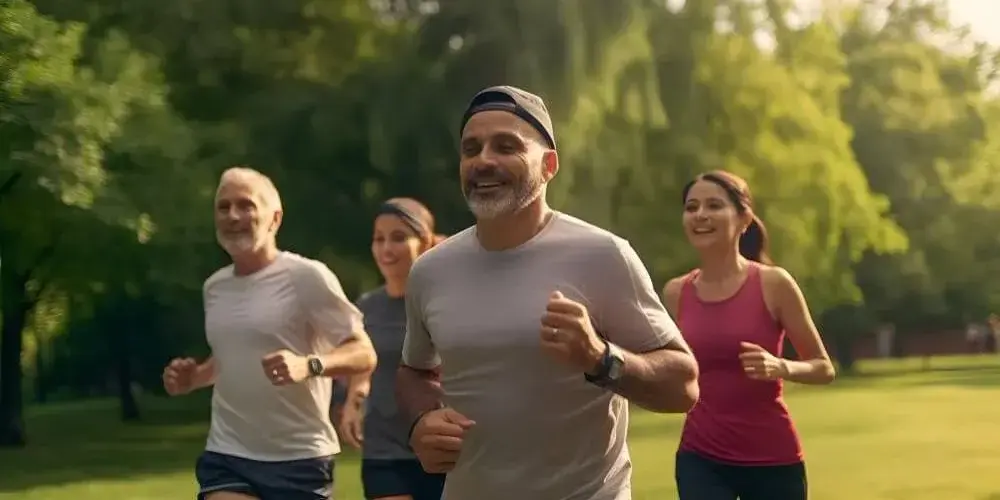
In today’s fast-paced world, it’s easy to become consumed by work, technology, and the daily grind. Unfortunately, this sedentary lifestyle comes at a cost – our health. This is where physical activity steps in as a true game-changer. It’s the essential ingredient for a vibrant life, improving everything from physical fitness to mental health. Let’s explore why you should make physical activity a non-negotiable part of your routine.
What is Physical Activity?
Everyday Activities
Even daily routines like walking to the store, doing chores, gardening, or actively playing with children all count as physical activity.
Occupational Activities
Jobs that require being on your feet and moving around (e.g., construction, delivery, healthcare) can contribute substantially to your physical activity.
Structured Exercise
Exercise is the most recognizable form of physical activity. This includes planned, purposeful movement with the goal of improving physical fitness. Types of exercise include:
- Aerobic Exercise: Activities that get your heart rate up and use large muscle groups like running, swimming, dancing, and cycling
- Strength Training: Exercises that build muscle mass and strength, such as lifting weights, resistance bands, or bodyweight exercises.
- Flexibility/Stretching: Activities that improve your range of motion and reduce stiffness, like yoga, Pilates, or simple stretches.
- Balance Exercises: Activities that help improve stability and coordination, are important for fall prevention, like tai chi.
Important Things to Know
1. Intensity Matters
Physical activity comes in levels of intensity from light (minimal effort) to moderate (noticeable increase in breathing and heart rate) to vigorous (rapid breathing, difficulty speaking in full sentences). Health benefits increase with more intensity.
2. Every Little Bit Counts
Even short bouts of physical activity spread throughout the day are beneficial. Focus on moving more, more often.
3. Listen to Your Body
You should push yourself, but it’s essential to pay attention to pain signals and not overdo it, especially if you’re new to being active.
The Wonders of Physical Activity
Physical activity is truly a wonder potion for the human body and mind. Here’s a deeper look at its powerful effects:
Physical Health Benefits
- Heart Health Champion: Regular physical activity strengthens your heart, making it more efficient at pumping blood. This lowers your risk of heart disease, stroke, and type 2 diabetes.
- Weight Management: Physical activity helps you burn calories. Combined with a healthy diet, it aids in achieving and maintaining a healthy weight, or even facilitates weight loss if needed.
- Strength and Endurance: Weight-bearing and resistance exercises build stronger muscles, making everyday tasks easier. Cardio boosts your lungs’ capacity and helps your body utilize oxygen more efficiently.
- Bone Boost: Physical activity, especially weight-bearing exercise, can help maintain bone density and reduce the risk of osteoporosis.
- Chronic Disease Management: Physical activity plays a crucial role in preventing and managing conditions like high blood pressure, arthritis pain, and some types of cancer.
Mental and Emotional Well-being
- Stress Buster: Physical activity is a natural stress reliever. It helps reduce levels of stress hormones like cortisol and increases the production of mood-boosting endorphins.
- Mood Elevator: Consistently being active promotes positive feelings, reduces symptoms of depression and anxiety, and enhances overall well-being.
- Sharper Mind: Studies show that exercise can improve cognitive function, memory, and focus. It may even protect against age-related cognitive decline.
- Sleep Aid: Regular physical activity promotes deeper, more restful sleep.
- Self-Confidence Boost: The accomplishment of getting stronger, improving fitness, or tackling new physical challenges translates to increased self-esteem.
Beyond the Individual: Societal Impact
- Reduced Healthcare Costs: A physically active population helps lower overall healthcare costs due to lower rates of chronic disease.
- Stronger Communities: Opportunities for physical activity like parks, trails, and community programs promote social connection and create healthier, more vibrant communities.
Important Note: If you have any existing health conditions, talk to your doctor before starting a new exercise program. They can guide you safely so you experience the maximum benefits of physical activity.
How Much Physical Activity Do You Need?
For significant health benefits, most adults should aim for the following guidelines, as recommended by trusted sources like the World Health Organization and the Centers for Disease Control & Prevention:
1. Aerobic Activity
- Moderate intensity: At least 150 minutes (2 hours and 30 minutes) per week. Examples include brisk walking, water aerobics, dancing, or doubles tennis.
- Vigorous-Intensity: At least 75 minutes (1 hour and 15 minutes) per week. Examples include running, swimming laps, hiking uphill, or singles tennis.
- Combination: An equivalent mix of moderate and vigorous-intensity aerobic activity is also highly beneficial.
2. Muscle-Strengthening Activities
Engage in exercises that work all major muscle groups (legs, hips, back, abdomen, chest, shoulders, and arms) at least two days per week. Example activities include lifting weights, using resistance bands, or bodyweight exercises like push-ups or squats.
3. Important Things to Note
- More is better: Even exceeding the recommended amounts leads to more substantial health benefits.
- Spread it Out: Distribute your activity across multiple days of the week rather than cramming it in all at once.
- Something is better than nothing: Any amount of physical activity is beneficial. If you find the guidelines to be overwhelming, start with shorter durations and gradually increase over time.
- Age Matters: Older adults (65+) should follow similar guidelines and include balance training exercises to promote stability and prevent falls.
- Special Considerations: If you’re pregnant, have chronic health conditions, or are just getting started with exercise, consult your doctor to determine the best and safest amount of physical activity for you.
4. Tips for Fitting Activity into Your Day
- Break it Up: Even short bouts (10-15 minutes) throughout the day add up.
- Make It Routine: Choose a consistent time that works for your schedule.
- Find What You Love: Explore different activities until you find things you enjoy doing.
- Be Mindful: Incorporate more movement into daily tasks – Take the stairs, park further away, and walk while you talk on the phone.
Tips to Get Started with Physical Activity
- Set SMART Goals: Instead of vague ideas, formulate specific, measurable, achievable, relevant, and time-bound goals. For example, instead of “get in shape,” aim for “walk briskly for 30 minutes, 3 days a week.”
- Start Small and Gradually Increase: If you’re new to exercise, don’t try to tackle too much too soon. Begin with 10-15 minute sessions and slowly add time and intensity over weeks and months.
- Find Your Fun: Make it enjoyable! Experiment with different activities like swimming, hiking, group fitness classes, or playing active games until you find things you genuinely look forward to.
- Buddy Up: Finding a workout partner provides accountability, motivation, and makes exercise more social.
- Schedule It: Treat your workouts like important appointments. Put them in your calendar and set reminders.
- Break Up Your Activity: If you can’t dedicate 30 minutes at once, aim for multiple shorter sessions throughout the day.
- Be Kind to Yourself: Setbacks happen. Don’t get discouraged; just pick up where you left off. Focus on progress, not perfection.
- Reward Your Efforts: Celebrate your milestones, even small ones, with non-food rewards like a new workout outfit, a relaxing bath, or an episode of your favorite show.
- Track Your Progress: Use a fitness tracker, journal, or app to monitor your workouts. Seeing your improvements is incredibly motivating.
- Focus on the “Why”: Remind yourself of the reasons you want to be active. Better health? More energy? Stress relief? Keep your “why” front and center when motivation wanes.
Additional Tips for Overcoming Common Barriers
- “I don’t have time”: Utilize pockets of time: take a walk on your lunch break, do short bodyweight workouts during TV commercials, or wake up a bit earlier.
- “I’m too tired”: Ironically, being active gives you more energy. A short walk can revitalize you more than a nap.
- “I don’t like gyms”: You don’t need a gym membership to be active! There are endless outdoor activities, home workouts, and online classes.
- “I have physical limitations”: Talk to your doctor or a physical therapist about developing a safe and effective exercise plan that suits your specific needs.
Remember, any step you take towards greater physical activity is a step towards a healthier, happier you!





